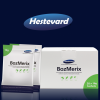Supporting horses grazing on bare ground?

During COVID-19, we’re very conscious that many competition and leisure horses are being turned out on paddocks that are bare, or into sand arenas and fields where grazing is almost impossible.
Grazing on parched grass is a danger for many horses. As they grasp at the grass shoots or bare ground, they will ingest large amounts of sandy particles – even in areas where soils are not particularly sandy. As grass levels reduce in prolonged dry periods, horses will continue to graze, and will churn the top level of soil to access grass roots and lower shoots. This leads to several health issues and is a factor in Sand Colic.
Sand Colic is abdominal pain secondary to ingesting sand and/or soil. All ages and breeds of horses are predisposed to Sand Colic. (Ragle CA, et al.)
Of course, when a horse ingests sand, it not only leads to reduced performance in training and will in turn result in reduced overall condition and wellbeing.
Symptoms of too much soil and sand in the gut may include:
- Reduced performance
- Weight loss
- Resistance
- Reduced appetite and willingness to eat
- Abdominal pain which re-occurs
- Appears depressed
- Running hot or appearing to sweat more than normal
- Cribbing
- Unsettled during saddling
If your horse appears unsettled in a combination of these symptoms, then it is wise to seek clinical advice – a diagnosis will be made based on test, clinical symptom observation and consideration of the environment where the horse is being grazed.
When a horse ingests soil, it can sit in the stomach and large intestine and can lead to impaction. When fine sand particles remain in the gut for an extended period of time, the intestinal wall will become irritated, thickened and may lead to mucosal ulcers forming in the colon. Additionally, this may lead to bowel dysfunction and reduce the absorption of food, vitamins and nutrients.
Prevention:
The simplest way to avoid sand colic is to ensure there is sufficient grazing before turning out horses, though easier said than done – especially in the summer months.
The following may also help:
- Rotate paddock grazing where possible – allowing grass to refresh. The use of temporary fencing assists with this. Paddock Pen Systems such as Duracorral will assist with this paddock management.
- Use rubber matting under troughs for water and feed in stables
- Introduce vitamin & mineral field licks
- Remove horses from sandy pastures where possible in periods of low grass availability
- Administer a daily or weekly supplement of psyllium husk (Hammond PD et al)
As with all cases of colic in horse’s, veterinarian advice should be sought immediately once symptoms become apparent
Why choose Hestevard Colonaid?
Hestevard Colonaid contains psyllium husk, a bulk forming fibre which assists with mobility through, and removal of sand particles from the colon.
Psyllium seed husks are able to absorb large amounts of water. Once psyllium enters the digestive tract, it can increase in volume as much as five times or greater. The resulting gelatinous substance helps support intestinal regularity to help move accumulated sand out with the stool. Psyllium is believed to have a better ability to penetrate, hydrate, and disrupt sand impactions than other laxatives (Sullins KE; Ferraro GL).
Psyllium is believed to work by stimulating intestinal motility and by making the sand stick together, allowing the horse to pass the sand. Other laxatives such as mineral oil is generally ineffective because they tend to float over the surface of the impaction. Rehydration and over-hydration with intravenously administered fluids can help add moisture content to the lumen in the area of the impaction.
Further details on Hestevard Colonaid Click here
References:
Ferraro GL: Diagnosis and treatment of sand colic in the horse. Vet Med Small Anim Clin 68:736, 1973.
Hammock PD, Freeman DE, Baker GJ: Failure of psyllium mucilloid to hasten evacuation of sand from the equine large intestine. Vet Surg 27:547-554, 1998.
Ragle CA, Meagher DM, Schrader JL, et al: Abdominal auscultation in the detection of experimentally induced gastrointestinal sand accumulation. J Vet Intern Med 3:12-14, 1989.
Sullins KE: Sand impaction, in White NA (ed): The Equine Acute Abdomen. Philadelphia, Lea & Febiger, 1990, pp 376-377.
Udenberg T: Equine colic associated with sand impaction of the large colon. Can Vet J 20:269-272, 1979


 Free Next Working Delivery on all orders over £75+VAT
Free Next Working Delivery on all orders over £75+VAT Bulk discount save more on large quantities
Bulk discount save more on large quantities 




